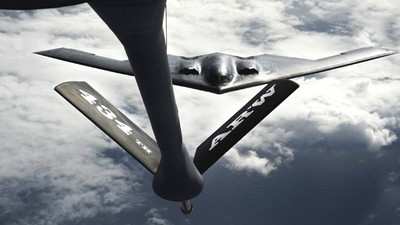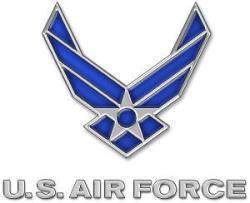Inclement Weather Prevented Raptors, F-16s From Joining In
Airmen aboard a B-2 Spirit tested their endurance in a 24-hour,
8,000-mile mission to Alaska and back to Guam March 12, in an
exercise showcasing US commitment to peace and stability throughout
the Pacific region.

Four B-2s and 270 Airmen from the 13th Expeditionary Bomb
Squadron are deployed to Andersen Air Force Base from Whiteman Air
Force Base, MO. This was the first bomber to complete the Polar
Lightning Exercise since their arrival in late February.
Polar Lightning missions are flown to showcase the global reach
and power of US bomber force and at the same time the sorties give
aircrews an opportunity to hone their skills. During the exercise,
a B-2 Spirit aircrew flew for 11 hours to Alaska. After it arrived
at the Alaskan Range, the stealth-bomber dropped more than 6,000
pounds of ordnance during two hours of range time, then returned to
Andersen AFB.
"Most missions for bombers are long-duration flights like what
we did during Polar Lightning," said Maj. Beth Makros, the 13th EBS
assistant director of operations and mission planner for this
exercise. "It is important that we practice like we play, and Polar
Lightning provides a great opportunity for our aircrew to get some
long endurance experience."
Although the stealth-bomber was originally scheduled to
participate with F-22 Raptors, E-3 Sentries and F-16 Fighting
Falcons from Elmendorf and Eielson Air Force bases in Alaska, the
B-2 aircrews were still able to gain valuable training after
inclement weather in Alaska prevented the other airframes from
integrating with the B-2s.
 "The training that the aircrew got was invaluable, and even
though some of the players were unable to participate due to
weather, we developed strong contacts with the other units for
future Polar Lightning exercises," Major Makros said.
"The training that the aircrew got was invaluable, and even
though some of the players were unable to participate due to
weather, we developed strong contacts with the other units for
future Polar Lightning exercises," Major Makros said.
Polar Lightning is a frequent exercise, taking place
approximately once a month. In order to fly such a long-duration
mission, many preparations must be made. From eating the right
diet, to lining up tanker aircraft support, to a good night's rest,
preparation is key to a successful mission, the major said.
Making sure B-2s have enough fuel to complete their missions are
Airmen aboard KC-135 Stratotankers from the 434th Air Refueling
Squadron deployed here from Grissom Air Reserve Base, Ind.
"The tanker support here has been phenomenal. For this exercise,
we had to refuel three times before the mission was over, and to
ensure our success, not only did they have a tanker escort us to
Alaska, but they prestaged tankers at Alaska to get us back home as
well," Major Makros said.
Another important player in the exercise was the flight doctor,
who monitored the pilots' sleep schedule and diet to make sure
their level of alertness was as high as it could be during the
stressful situation.
The mission also had to be scheduled so when they arrived in
Alaska, the time of day was accurate so the ability of the stealth
bomber was at its peak.
Although all the coordination and preparation was a lot of hard
work, in the end it was worth the effort, the major said.
"The experience the crew gained from the exercise and taking off
from a new location was completely irreplaceable, and without help
from various players, it wouldn't have been possible," she
said.
The Airmen and B-2s are part of a regularly scheduled air and
space expeditionary force rotation of bombers that has been
underway since 2003. The bomber rotation is aimed at enhancing
regional security and demonstrating US commitment to the Pacific
region.
 ANN's Daily Aero-Term (05.29.25): Terminal Radar Service Area
ANN's Daily Aero-Term (05.29.25): Terminal Radar Service Area ANN's Daily Aero-Term (05.30.25): Very High Frequency (VHF)
ANN's Daily Aero-Term (05.30.25): Very High Frequency (VHF) Aero-News: Quote of the Day (05.30.25)
Aero-News: Quote of the Day (05.30.25) Airborne 05.23.25: Global 8000, Qatar B747 Accepted, Aviation Merit Badge
Airborne 05.23.25: Global 8000, Qatar B747 Accepted, Aviation Merit Badge ANN's Daily Aero-Linx (05.30.25)
ANN's Daily Aero-Linx (05.30.25)




